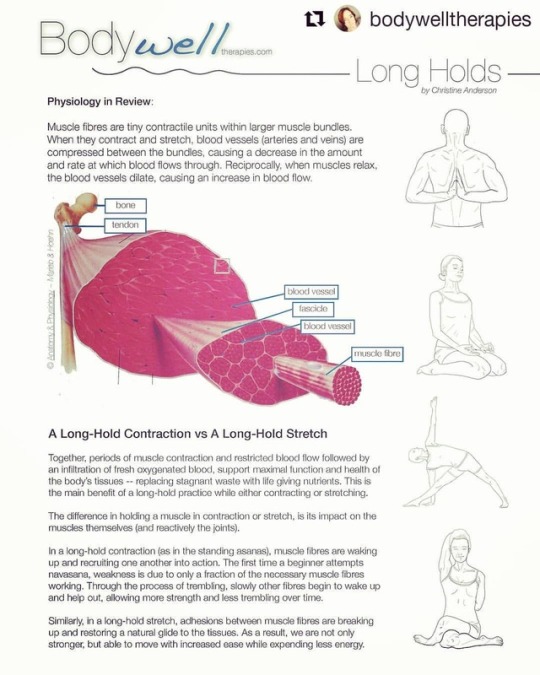#musclephysiology
Photo

“EXCITATION AND CONTRACTION:
1.) A nerve impulse reaches the end of a motor neuron and triggers release of the neurotransmitter acetylcholine (ACh).
2.) ACh diffuses rapidly across the gap of the neuromuscular junction and binds to ACh receptors on the motor endplate of the muscle fiber.
3.) Stimulation of ACh receptors initiates an impulse that travels along the sarcolemma, through the T tubules, to the sacs of the sarcoplasmic reticulum (SR).
4.) Calcium (Ca2+) is released from the SR into the sarcoplasm, where it binds to troponin molecules in the thin myofilaments.
5.) Tropomyosin molecules in the thin myofilaments shift and thereby expose actin’s active sites.
6.) Energized myosin cross bridges of the thick myofilaments bind to actin and use their energy to pull the thin myofilaments toward the center of each sarcomere. This cycle repeats itself many times per second, as long as adenosine triphosphate is available.
7.) As the filaments slide past the thick myofilaments, the entire muscle fiber shortens.”
(Patton, Kevin T., and Gary A. Thibodeau. “Muscle Contraction.” Anatomy and Physiology, 9th ed., Elsevier, Inc., 2016, p. 367.)
#anatomyandphysiology #anatomy #anatomydrawing #art #muscles #muscularsystem #sarcomere #physiology #student #studygram #traditionalart #drawing #pen #science #studying #musclephysiology #premed #humanbody
https://www.instagram.com/p/B-gOE7RFqIx/?igshid=1tut7yvj121ty
#anatomyandphysiology#anatomy#anatomydrawing#art#muscles#muscularsystem#sarcomere#physiology#student#studygram#traditionalart#drawing#pen#science#studying#musclephysiology#premed#humanbody#my art
1 note
·
View note
Link
How do we draw physiology? How do we explain complicated structures and processes through drawing? Click to view one of our Physiology tutorials and see what a difference our approach makes to how you learn medical sciences!
#physiology#anatomyandphysiology#eccoupilng#musclephysiology#drawphysiology#drawscience#drawtolearn#drawmedicine#medicalschool#medicalscience
5 notes
·
View notes
Photo

Active Transport Intro · ‘Active transport is the process of transferring substances into, out of, and between cells, using energy. In some cases, the movement of substances can be accomplished by passive transport, which uses no energy. However, the cell often needs to transport materials against their concentration gradient.’ - https://biologydictionary.net/active-transport/ · Substances which cannot be diffused would be selected (e.g. too large solutes or they are incapable of dissolving in the lipid bilayer). · There are two types of active transport: o Primary o Secondary Primary Active Transport · ‘Primary active transport is also called direct active transport or uniport. It involves using energy (usually ATP) to directly pump a solute across a membrane against its electrochemical gradient.’ · Solute are transported across by the hydrolyses of ATP which changes the protein shape. This enables the solute to be pumped across. · An example of primary active transport is the Sodium-potassium pump (Na+ K+ pump). The pump drives Na+ out of the cell against a steep concentration gradient & pumps K+ back in. Secondary Active Transport · ‘In secondary active transport, also known as coupled transport or cotransport, energy is used to transport molecules across a..... Reference · https://biologydictionary.net/active-transport/ · https://microbenotes.com/active-transport/ · Marieb & Hoehn. Human Anatomy and Physiology. 10th ed. Chapter 3 . . . #discoverphysiotherapy #physiotherapists #physiotherapystudents #physioworld #physio #physiologyfirst #physiology_notes #physiologyfacts #physiologyofactivity #anatomyandphysiology #sportphysiology #humananatomyphysiology #musclephysiology #psychophysiology #transport #active #activetransport #activetransportation #new #daily #dailypost #tuesdayvibes #tuesday #tuesdaymotivation #tuesdaythoughts #cell #cells #biology🔬 #biologyislife #biologynotes https://www.instagram.com/p/CECLy_an2Tb/?igshid=1agegrhurfpn4
#discoverphysiotherapy#physiotherapists#physiotherapystudents#physioworld#physio#physiologyfirst#physiology_notes#physiologyfacts#physiologyofactivity#anatomyandphysiology#sportphysiology#humananatomyphysiology#musclephysiology#psychophysiology#transport#active#activetransport#activetransportation#new#daily#dailypost#tuesdayvibes#tuesday#tuesdaymotivation#tuesdaythoughts#cell#cells#biology🔬#biologyislife#biologynotes
0 notes
Photo

#Repost @bodywelltherapies 💖🧠💖 (@get_repost) ・・・ Compression in yoga & massage: . . Muscle fibers are tiny contractile units within larger muscle bundles. When they contract and stretch, blood vessels (arteries & veins) are compressed between the bundles, causing a decrease in the amount and rate at which blood flows through. Reciprocally, when muscles relax, the blood vessels dilate, causing and increase in blood flow. . . Together, periods of muscle contraction and restricted blood flow followed by an infiltration of fresh oxygenated blood, support maximal function and health of the body’s tissues— replacing stagnant waste with life-giving nutrients. This is the main benefit of a long-hold practice (either contracting or stretching). . . The difference in holding a muscle in contraction or stretch, is its impact on the muscles themselves, and reactively the joints. Sustained compression in #massagetherapy has similar circulatory effects & can effectively release a lot of tension. . . In a long hold contraction (as in standing asanas), muscle fibers are waking up and recruiting one another into action. The first time a beginner attempts #navasana weakness is due to only a fraction of the necessary muscle fibers working. Through the process of trembling, slowly other fibers begin to wake up and help out, allowing more strength and less trembling over time. . . Similarly, in a long-hold stretch, adhesions between muscle fibers are breaking up and restoring a natural glide to the tissues. As a result, we are not only stronger, but able to move with increased ease while expending less energy. . . ©️this is a page from my modular 200, 300, 500 #yogateachertraining manual. 🔗link in bio. . . 📸 throw back to Costa Rica circa 2001. I’m compressing my spine and abdominal aorta in this #backbend while #yogaforrunners is in action towards #pindasana compressing her femoral arteries and thyroid . . . #circulation #yoga #yogaasana #bodywelltherapies #anatomynerd #bodyintelligence #ottawamassage #musclephysiology #ashtangayoga #iyengaryoga #beobssesedorbeaverage #iheartanatomy #somanaut #yogateacher https://www.instagram.com/p/BsYqzbOHtUl/?utm_source=ig_tumblr_share&igshid=13xvcb3bdjisz
#repost#massagetherapy#navasana#yogateachertraining#backbend#yogaforrunners#pindasana#circulation#yoga#yogaasana#bodywelltherapies#anatomynerd#bodyintelligence#ottawamassage#musclephysiology#ashtangayoga#iyengaryoga#beobssesedorbeaverage#iheartanatomy#somanaut#yogateacher
0 notes